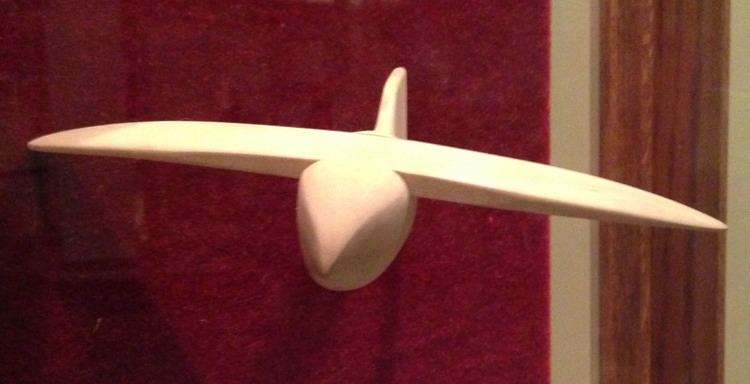Similar Helicopter hieroglyphs, Lake Winnipesaukee mystery st, Phaistos Disc, Nebra sky disk, Narmer Palette | ||
The saqqara bird
The Saqqara Bird is a bird-shaped artifact made of sycamore wood, discovered during the 1898 excavation of the Pa-di-Imen tomb in Saqqara, Egypt. It has been dated to approximately 200 BCE, and is now housed in the Museum of Egyptian Antiquities in Cairo. The Saqqara Bird has a wingspan of 180 mm (7.1 in) and weighs 39.12 g (1.380 oz). Its function is not understood because of a lack of period documentation.
Contents
- The saqqara bird
- Ancient egypt s ufo the 2 300 year old saqqara bird glider
- Conventional ideas
- Controversial ideas
- Attempts to prove the claim
- Position of tailplane
- References

Ancient egypt s ufo the 2 300 year old saqqara bird glider
Conventional ideas

Some think the Saqqara Bird may be a ceremonial object because the falcon, the bird after which the Saqqara Bird is modeled, is the form most commonly used to represent several of the most important gods of Egyptian mythology, most notably the falcon deity Horus and the sun deity Ra Horakhty. Others have posited it may have been a toy for an elite child, or that it could have functioned as a weather vane. Some have also speculated it may have been used as a sort of boomerang, as such technology was common and well known in ancient Egypt in the form of a throwing stick used for hunting waterfowl. But the most likely hypothesis is that this bird was positioned on the masthead of sacred boats used during the Opet Festival. Reliefs showing those boats are found in the Temple of Khonsu at Karnak and date to the late New Kingdom.
Controversial ideas

Some have suggested that the Saqqara Bird may represent evidence that knowledge of the principles of aviation existed many centuries before such are generally believed to have first been discovered. Egyptian physician, archaeologist, parapsychologist and dowser Khalil Messiha has speculated that the ancient Egyptians developed the first aircraft. He wrote that it "represents a diminutive of an original monoplane still present in Saqqara." He also claimed that the Saqqara Bird could function as a glider if it had a horizontal tailplane, which he "suppose[d] was lost," and noted that the Egyptians often placed miniaturized representations of their technology in their tombs.

Messiha contended that the Saqqara Bird differs significantly from other statues and models of birds housed in the Cairo museum. According to Messiha, the Saqqara Bird has a vertical stabilizer which is unlike the generally horizontal shape of a real bird's tail. Richard P. Hallion described this fin as "shaped as if the bird had twisted its tail feathers." It is also legless and has wings set at an angle Messiha sees as similar to that of modern aircraft, which he considered an attempt to create aerodynamic lift.

In spite of these claims, however, no ancient Egyptian aircraft have ever been found, nor has any other evidence suggesting their existence come to light. As a result, the theory that the Saqqara Bird is a model of a flying machine is not accepted by mainstream Egyptologists. Hallion notes that it is "far too heavy and unstable itself to fly."
Attempts to prove the claim

Messiha built a model of the Saqqara Bird to test for its aerodynamic efficiency. His model was six times larger than the dimensions of the original in an attempt to maintain its proportional aerodynamic efficiency, and was given a horizontal tailplane to act as a stabilizer, which Messiha believed is a missing part of the original model. Messiha insisted that he was able to make his model fly.
In an attempt to discover whether claims of aerodynamic properties of the Saqqara Bird were correct, Martin Gregorie, a builder and designer of free flight gliders, built a replica of the Saqqara Bird made of balsa wood. After testing this replica, Gregorie concluded: "the Saqqara Bird never flew. It is totally unstable without a tailplane ... Even after a tailplane was fitted the glide performance was disappointing." He added: "the Saqqara Bird was probably made as a child's toy or a weather vane."
According to Messiha's son, Dawoud Khalil Messiha, an architect who continued the work of his father, Gregorie's suggestion that the Saqqara Bird could be a weather vane is impossible due to the lack of markings or holes on the model that would serve as a means of hanging it. Dawoud Khalil Messiha noted that the only hole that exists on the bottom of the Saqqara Bird is a recent one and was made by museum officials to fix the model on a stick with reference to a model description in Cairo museum records.
Aerodynamics expert Simon Sanderson tested a replica model in a wind tunnel without a tailplane and found that it produced “four times the glider’s own weight in lift.” In Liverpool University, Sanderson then subjected it with the data from wind tunnel and added a stabilizing tailplane to a flight simulator meant to replicate “the same trials as a modern fighter jet.” In virtual air streams and conditions in Egypt, the Saqqara Bird actually flew quite well. “Over 2,000 years after the ancient Egyptians carved this mysterious bird, modern technology has proved beyond doubt that it could have flown.”
Position of tailplane
Messiha claims "The lower part of the tail is broken [i.e. flat] which I think may be an evidence that the tail was attached there."
